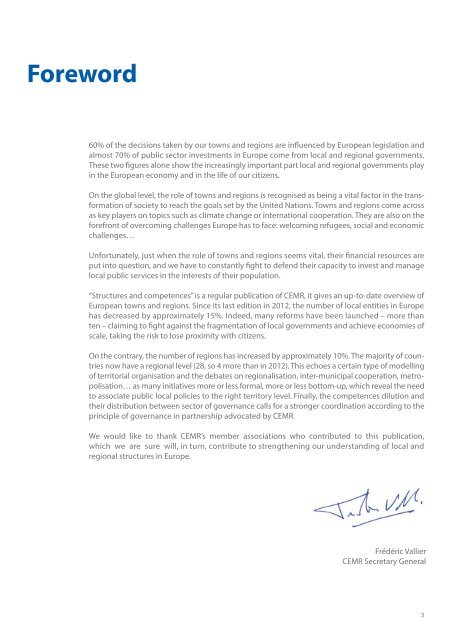Local and Regional Governments in Europe
CEMR_structures_and_competences_2016_EN
CEMR_structures_and_competences_2016_EN
You also want an ePaper? Increase the reach of your titles
YUMPU automatically turns print PDFs into web optimized ePapers that Google loves.
Foreword<br />
60% of the decisions taken by our towns <strong>and</strong> regions are <strong>in</strong>fluenced by <strong>Europe</strong>an legislation <strong>and</strong><br />
almost 70% of public sector <strong>in</strong>vestments <strong>in</strong> <strong>Europe</strong> come from local <strong>and</strong> regional governments.<br />
These two figures alone show the <strong>in</strong>creas<strong>in</strong>gly important part local <strong>and</strong> regional governments play<br />
<strong>in</strong> the <strong>Europe</strong>an economy <strong>and</strong> <strong>in</strong> the life of our citizens.<br />
On the global level, the role of towns <strong>and</strong> regions is recognised as be<strong>in</strong>g a vital factor <strong>in</strong> the transformation<br />
of society to reach the goals set by the United Nations. Towns <strong>and</strong> regions come across<br />
as key players on topics such as climate change or <strong>in</strong>ternational cooperation. They are also on the<br />
forefront of overcom<strong>in</strong>g challenges <strong>Europe</strong> has to face: welcom<strong>in</strong>g refugees, social <strong>and</strong> economic<br />
challenges…<br />
Unfortunately, just when the role of towns <strong>and</strong> regions seems vital, their f<strong>in</strong>ancial resources are<br />
put <strong>in</strong>to question, <strong>and</strong> we have to constantly fight to defend their capacity to <strong>in</strong>vest <strong>and</strong> manage<br />
local public services <strong>in</strong> the <strong>in</strong>terests of their population.<br />
“Structures <strong>and</strong> competences” is a regular publication of CEMR, it gives an up-to-date overview of<br />
<strong>Europe</strong>an towns <strong>and</strong> regions. S<strong>in</strong>ce its last edition <strong>in</strong> 2012, the number of local entities <strong>in</strong> <strong>Europe</strong><br />
has decreased by approximately 15%. Indeed, many reforms have been launched – more than<br />
ten – claim<strong>in</strong>g to fight aga<strong>in</strong>st the fragmentation of local governments <strong>and</strong> achieve economies of<br />
scale, tak<strong>in</strong>g the risk to lose proximity with citizens.<br />
On the contrary, the number of regions has <strong>in</strong>creased by approximately 10%. The majority of countries<br />
now have a regional level (28, so 4 more than <strong>in</strong> 2012). This echoes a certa<strong>in</strong> type of modell<strong>in</strong>g<br />
of territorial organisation <strong>and</strong> the debates on regionalisation, <strong>in</strong>ter-municipal cooperation, metropolisation…<br />
as many <strong>in</strong>itiatives more or less formal, more or less bottom-up, which reveal the need<br />
to associate public local policies to the right territory level. F<strong>in</strong>ally, the competences dilution <strong>and</strong><br />
their distribution between sector of governance calls for a stronger coord<strong>in</strong>ation accord<strong>in</strong>g to the<br />
pr<strong>in</strong>ciple of governance <strong>in</strong> partnership advocated by CEMR.<br />
We would like to thank CEMR’s member associations who contributed to this publication,<br />
which we are sure will, <strong>in</strong> turn, contribute to strengthen<strong>in</strong>g our underst<strong>and</strong><strong>in</strong>g of local <strong>and</strong><br />
regional structures <strong>in</strong> <strong>Europe</strong>.<br />
Frédéric Vallier<br />
CEMR Secretary General<br />
3
















